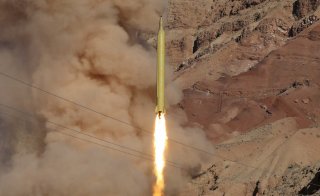Satellite Images: Iran Constructs New Ballistic Missile Launch Positions
The Iranian Khorgo underground ballistic missile site is believed to be nearly operational after satellite images revealed that new launch positions were built there.
The Iranian Khorgo underground ballistic missile site is believed to be nearly operational after satellite images revealed that new launch positions were built there.
The images, which were taken by Maxar Technologies and obtained by Fox News, showed four holes that were dug into the side of a mountain, with three of the shafts in hardened vertical launch positions, according to analysis conducted by the civilian intelligence group Intel Lab.
“Considering the geographic location as well as the existing topography, once this complex reaches full operational capability, it will not be an easy task to neutralize it by conventional means,” said Itay Bar-Lev, the chief Intel Lab analyst.
It is believed that the construction on the ballistic missile site began three years ago. It was only in recent months, however, Iranians started work on the launch positions that can each quickly fire two ballistic missiles.
This particular site, which is located in southwestern Iran, is situated roughly five hundred miles from Kuwait, a country that is home to more than thirteen thousand U.S. soldiers. It is also less than two hundred miles from the United Arab Emirates.
Earlier this week, Iran’s Revolutionary Guards Corps inaugurated a new underground missile facility that is akin to a “missile city” heavily armed with hundreds of cruise and ballistic weapons.
Iranian state television aired new footage of the facility but did not disclose the exact location. The video showed what appeared to be advanced munitions and an array of radars and electronic warfare equipment.
“What we see today is a small section of the great and expansive missile capability of Revolutionary Guards’ naval forces,” Guards commander Gen. Hossein Salami said on the broadcast.
Iran and the United States currently remain in a tense standoff, as both countries have indicated a desire to return to the 2015 Joint Comprehensive Plan of Action, which was the Iranian nuclear deal that gave the Middle Eastern country economic relief from sanctions in return for limits to its burgeoning nuclear program.
The new Joe Biden administration has acknowledged that it won’t lift sanctions unless Tehran reverses its breaches of the nuclear deal. Meanwhile, Iran has demanded that the United States lifts it sanctions first before engaging in any further talks.
Last week, a bipartisan group of a hundred forty representatives sent a letter to U.S. Secretary of State Antony Blinken, urging the Biden administration to address Iran’s growing military threat.
“As Democrats and Republicans from across the political spectrum, we are united in preventing an Iranian nuclear weapon and addressing the wide range of illicit Iranian behavior. Since the Joint Comprehensive Plan of Action entered into force, Iran has continued to test ballistic missile technology that could potentially be applied to nuclear capable missiles, funded and supported terrorism throughout the Middle East, and engaged in cyberattacks to disrupt the global economy,” the lawmakers wrote.
“Diplomacy with Iran must limit not only the production of nuclear material but also ensure that Iran cannot develop a nuclear-capable ballistic missile,” they added.
Ethen Kim Lieser is a Minneapolis-based Science and Tech Editor who has held posts at Google, The Korea Herald, Lincoln Journal Star, AsianWeek, and Arirang TV. Follow or contact him on LinkedIn.

